Da capo
- 1994
- Latex, Araldite & carborundum on steel plate
- 165 x 125,5 cm
- Cat. P_590
- Acquired in 1995
Francesc Torres' interest in restoring the disruptive, iconoclastic, ritual, violent power of certain cultural elements from the past and, more metaphorically, the present, lead him to re-use old images from a new conceptual viewpoint. These include such remote images as the Palaeolithic carving known as the Venus of Willendorf, which he reproduces in Da capo (1994). This title is an Italian musical term that means 'back to the beginning'. Here, it refers to our supposedly pristine origins and links up with metaphors for more recent events. Torres has referenced prehistoric art in several other pieces: cave paintings of hunters appear in MoMA Employees Are on Strike (2000, in the artist's own collection), and pictures of bison and other animals, emulating those on the painted ceilings of Altamira and other focal points for cave art, take centre stage in the installation The Repetition of Novelty, which he produced on the brick walls of the coal bunker at the PS1 in New York in 1977. But the Venus of Willendorf appears more often than any other product of material culture in his works. A composition identical to that in Da Capo in the Banco de España Collection was used on a plate containing a series of drypoint etchings; and the actual Venus sculpture appears in various attitudes as a found object in works such as Power Contested (Three Graces in Unstable Equilibrium) (1993, Contemporary Art Museum of Alicante).
It is Torres' fascination with reproducing art works from the past, particularly those which are least accessible (as is usually the case with prehistoric art) that underlies this type of work, which expose fetishism in regard to the art of the past and to archaeology and associate it with a certain popular devotion for contemporary art and the dynamics of advanced capitalism through souvenirs, advertising and the manipulated use of political propaganda. A case in point is the figure of Lenin in the navel of the menstruating Venus here, which harks back to a revindication by Torres of the female component of social revolutions. In this context, Da Capo criticises the whole aesthetic of simulation, which is not without its political and ideological connotations, such as those that drove the emergence of the Catalan conceptualist movement in which Torres was a pioneer. It is precisely that repetition and imitation which comes through in his early works, such as Imitation of Myself (1974, Museo Reina Sofía). His written text 'Da Capo', published to mark the exhibition of the same name at the MACBA in 2008, sets out these ideas in more depth: 'It is perfectly plausible to imagine a 'museum of the caves', organised perhaps under the auspices of the Smithsonian Institution in Washington [...] where visitors could go from Altamira to El Castillo, from La Pasiega to Lascaux, from Les Trois Frères to Parpalló without the stress and expense of old-school travel. That hypothetical museum could be reproduced as many times as there are Guggenheims, doing for Palaeolithic art what has been done for contemporary art: almost all museums are the same and their permanent collections contain practically the same things. This is a metaphor (at the risk of repeating myself) for the Western concept of democracy, that everyone wishes for, without realising, from birth.
Other works by Francesc Torres

